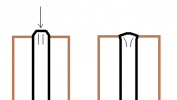Sorry for the beginner's question but... I'm a beginner, as of this weekend.
I am peening in brass pins with a peening hammer and on a vice that has a small flat hammering section.
How do know how much to peen the pins so they are secure, hold the scales and plates together, but don't crack the scales?
I would appreciate your advice, folks!
I am peening in brass pins with a peening hammer and on a vice that has a small flat hammering section.
How do know how much to peen the pins so they are secure, hold the scales and plates together, but don't crack the scales?
I would appreciate your advice, folks!


